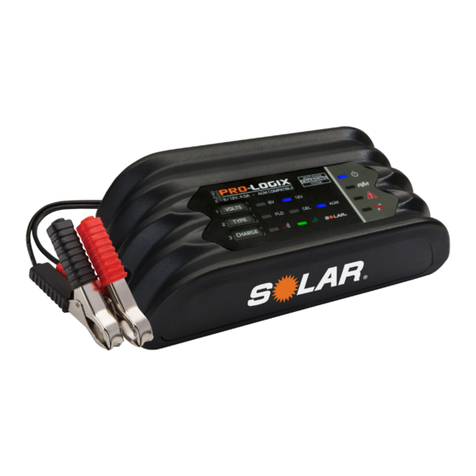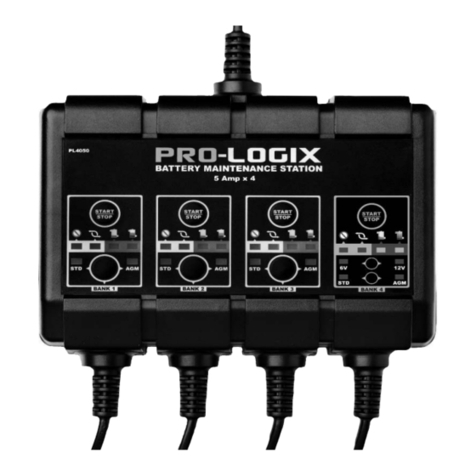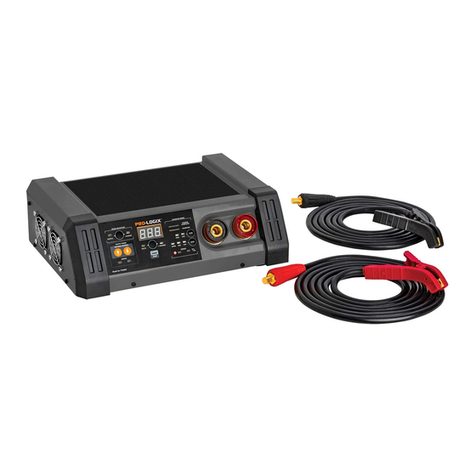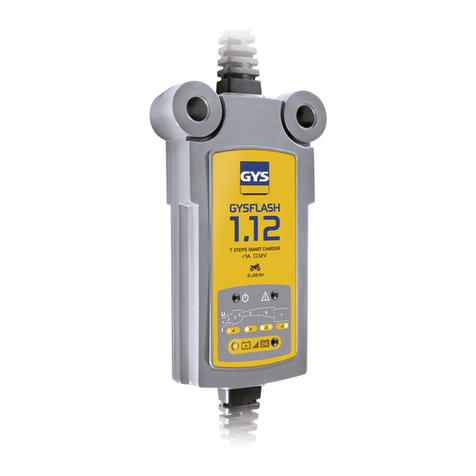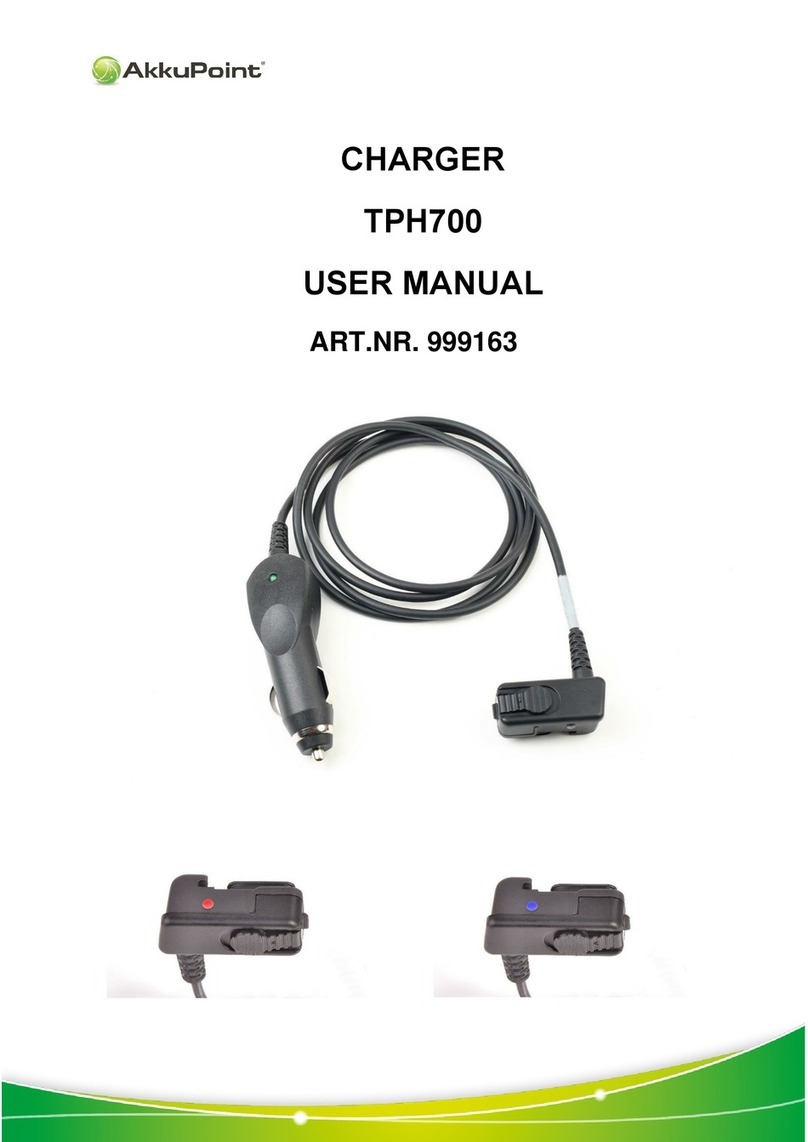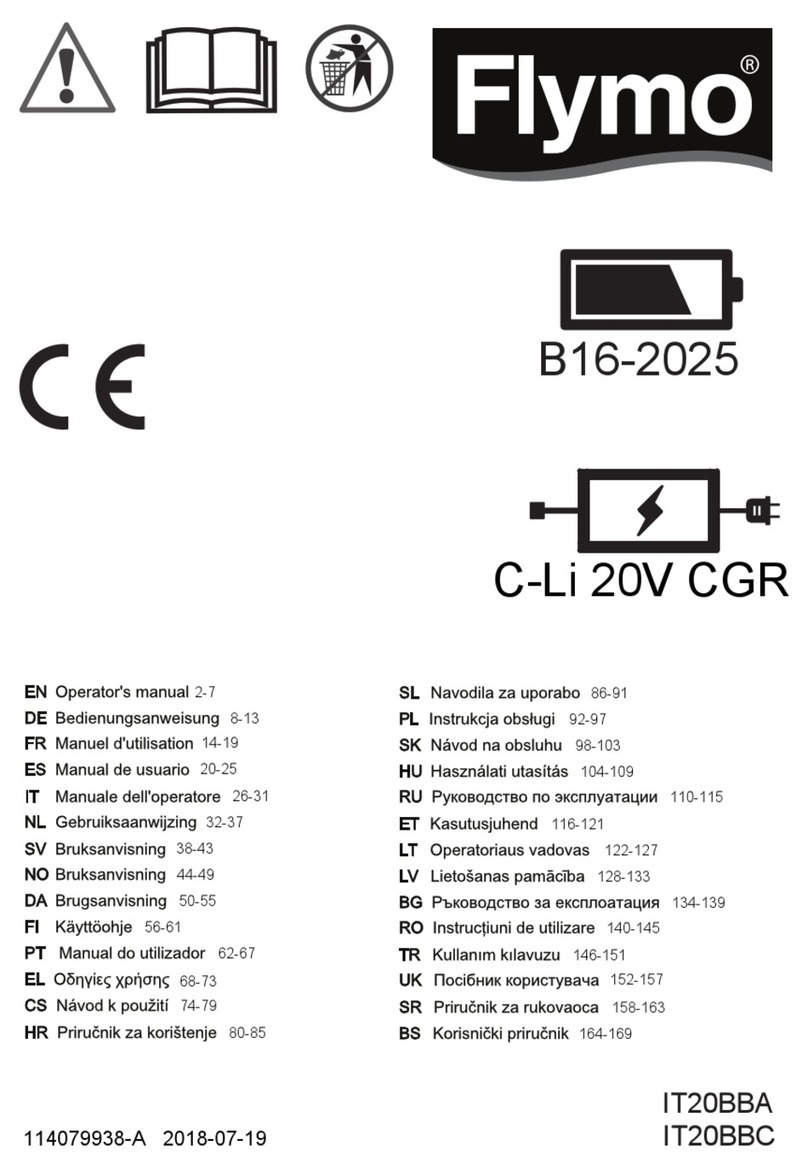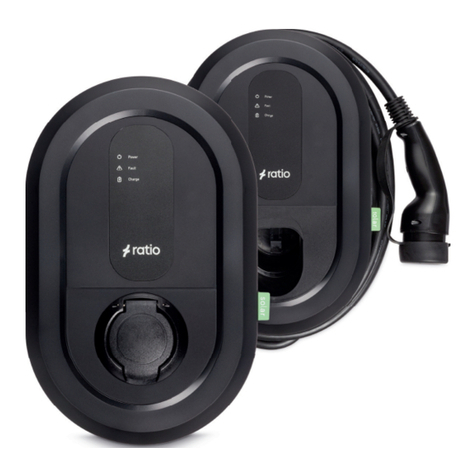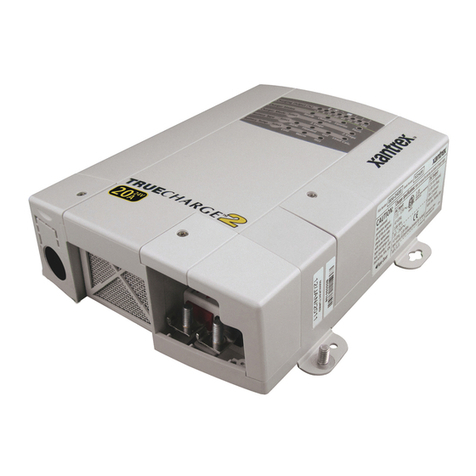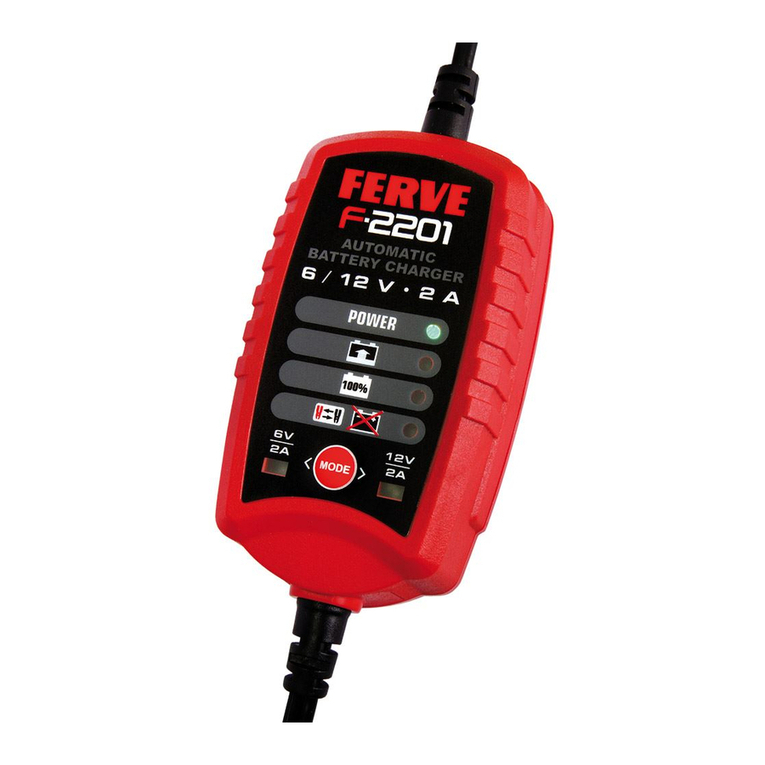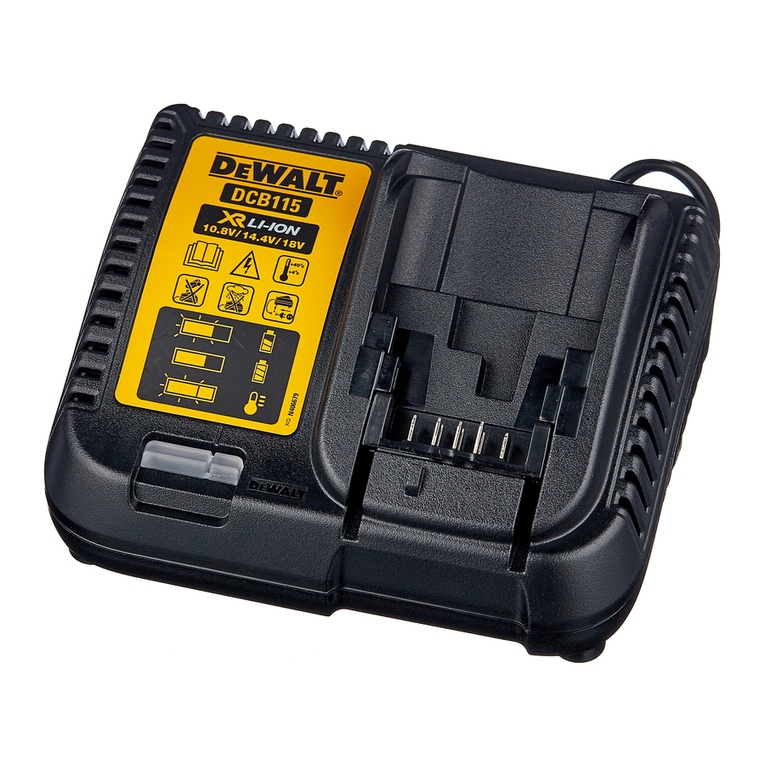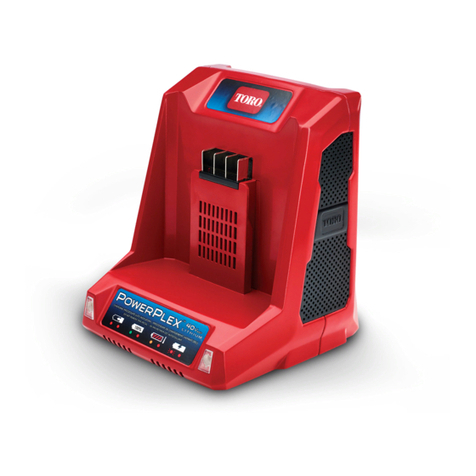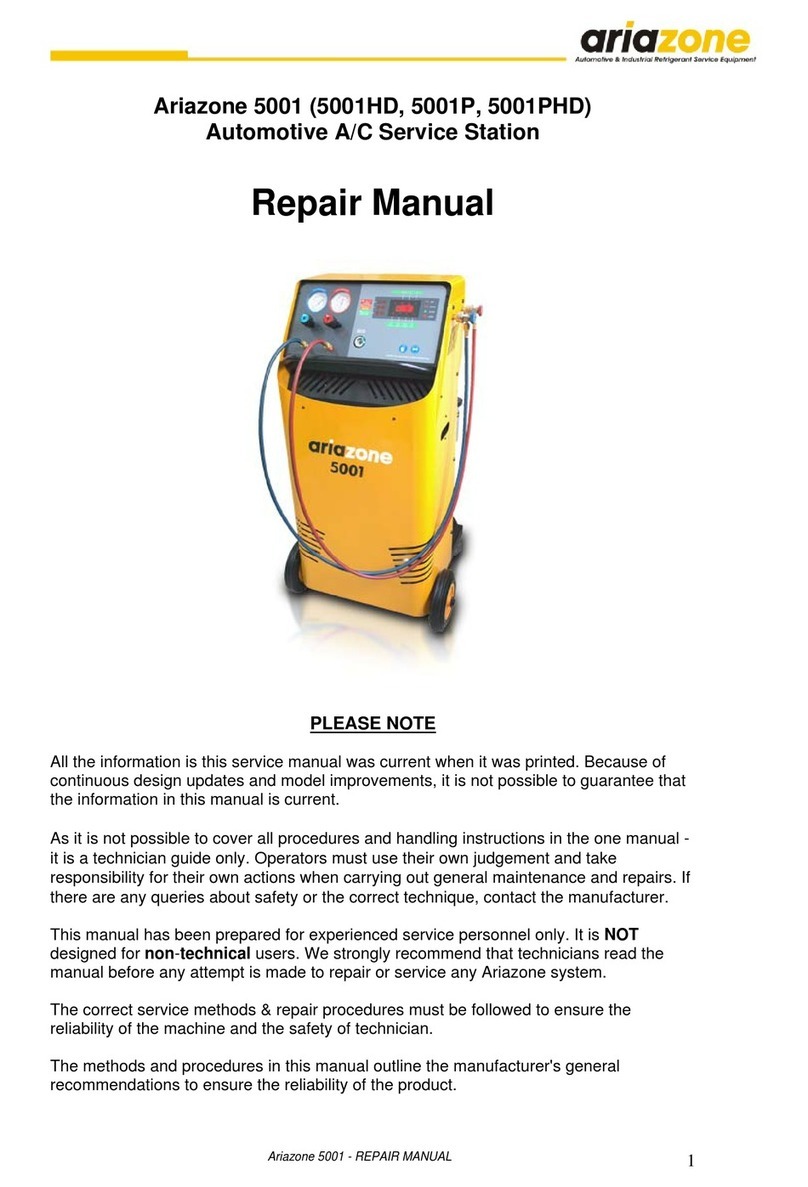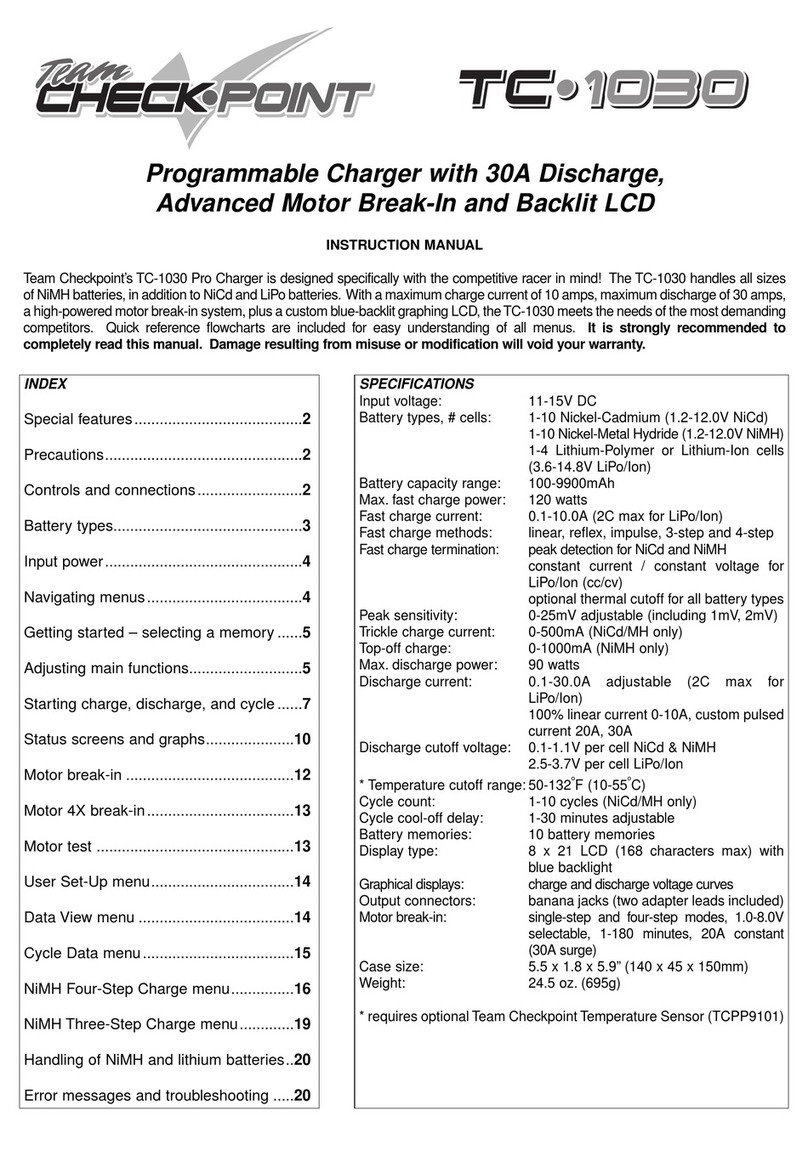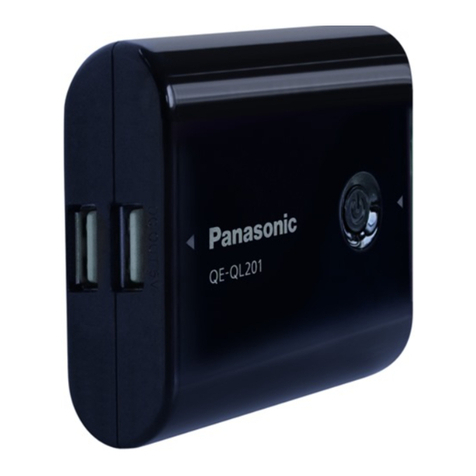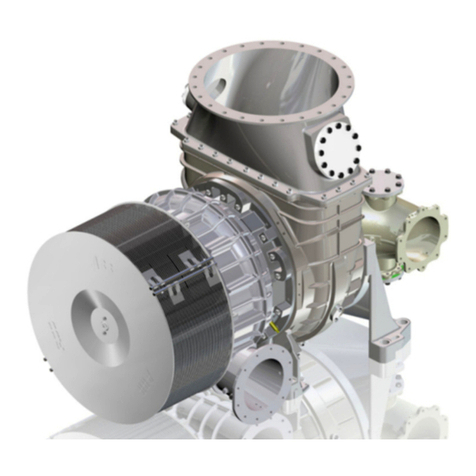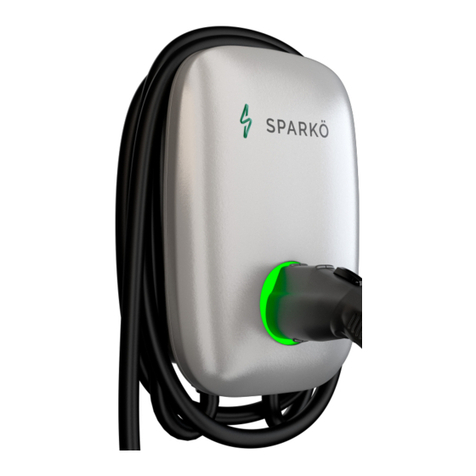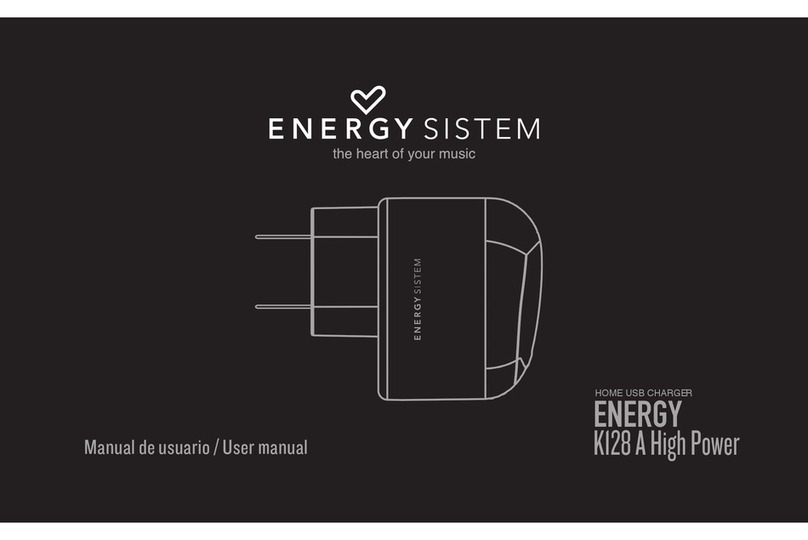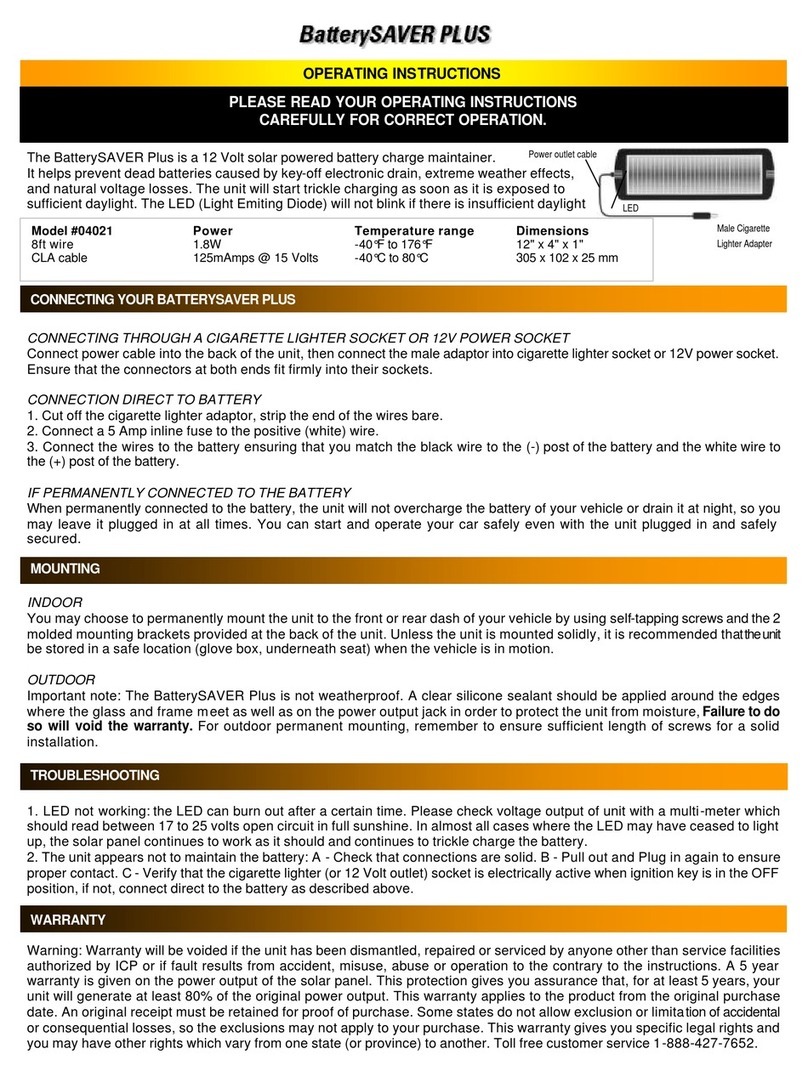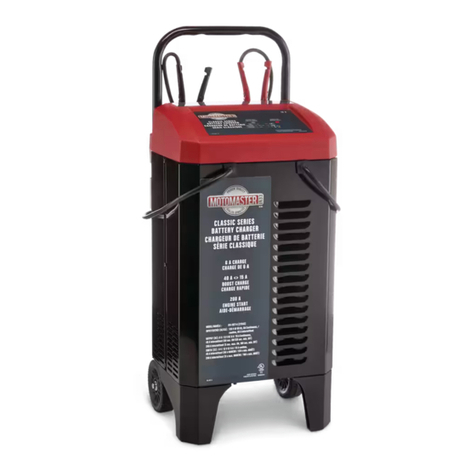Prologix SOLAR PL6100 User manual

SOLAR PL6100
Operator’s Manual
Failure to follow instructions may cause
damage or explosion, always shield eyes.
Read entire instruction manual before use.
WARNING
Includes information on SOLAR Model No. PL6100
Part No. 141-610-000
Warning: This product can expose you to chemicals,
including Vinyl-Chloride, Styrene and Acrylonitrile, which
are known to the State of California to cause cancer.
For more information go to www.P65Warnings.ca.gov

2
SAFETY SUMMARY
IMPORTANT SAFETY INSTRUCTIONS
SAVE THESE INSTRUCTIONS
SAVE THESE INSTRUCTIONS – This manual contains important safety and operating instructions for
Model No. PL6100.
WARNING
Read these instructions completely before using the SOLAR Battery Charger and save them for
future reference. Before using the SOLAR Battery Charger to charge a battery, read these
instructions and the instruction manual/safety information provided by the car, truck, boat or
equipment manufacturer. Following all manufacturers’ instructions and safety procedures will
reduce the risk of accident.
Working around lead-acid batteries may be dangerous. Lead-acid batteries release explosive gases
during normal operation, charging and jump starting. Carefully read and follow these instructions for
safe use. Always follow the specific instructions in this manual and on the SOLAR Battery Charger
each time you use the SOLAR Battery Charger.
All lead-acid batteries (car, truck and boat) produce hydrogen gas which may violently explode in
the presence of fire or sparks. Do not smoke, use matches or a cigarette lighter while near
batteries. Do not handle the battery while wearing vinyl clothing because static electricity sparks
are generated when vinyl clothing is rubbed. Review all cautionary material on the SOLAR Battery
Charger and in the engine compartment.
Always wear eye protection, appropriate protective clothing and other safety equipment when
working near lead-acid batteries. Do not touch eyes while working on or around lead-acid batteries.
Always store clamps away from each other or common conductors. Improper storage of clamps
may cause the clamps to come in contact with each other, or a common conductor, which would
be hazardous if the charger was plugged into an AC outlet.
Use extreme care while working within the engine compartment, because moving parts may cause
severe injury. Read and follow all safety instructions published in the vehicle's Owner's Manual.
Batteries being charged with the SOLAR Battery Charger unit likely contain liquid acids which are
hazardous if spilled.
Please read and retain these instructions for the continued safe use of your new charger. This manual contains
important safety information. DO NOT OPERATE this equipment UNTIL YOU HAVE READ this safety summary!
WARNING: Changes or modifications to this unit not expressly approved by the party responsible for
compliance could void the user’s authority to operate the equipment.
NOTE: This device complies with Part 15 of the FCC Rules. Operation is subject to the following two
conditions: (1) this device may not cause harmful interference, and (2) this device must accept any
interference received, including interference that may cause undesired operation.
This Class A industrial apparatus complies with Canadian ICES-003.

3
WARNING – Shock Hazards
1. NEVER attempt to charge a marine (boat) battery while the boat is on or near the water. A boat
must be on a trailer and located indoors before attempting to charge its battery(s). The boat
manufacturer’s battery charging instructions must be followed exactly.
2. NEVER set the charger, output cable or clamps, or AC power cord plug in water or on wet surfaces.
3. NEVER use this charger on a pier or dock. Charger could fall in water, creating an electric shock
hazard.
4. NEVER attempt to plug in or operate the battery charger with defective or damaged wires, power
cord, or power cord plug. Have any of these parts that are defective or damaged replaced by
qualified personnel IMMEDIATELY.
5. NEVER attempt to plug in the charger or operate its controls with wet hands or while standing in
water.
6. NEVER alter the AC power cord or power cord plug provided with the battery charger.
7. NEVER use an attachment not recommended or sold by Clore Automotive for use with this specific
model battery charger. Use of such attachment may result in risk of fire, electric shock or injury to
persons.
8. NEVER operate this battery charger if it has received a sharp blow, been dropped, or similarly
damaged, until after being inspected and/or repaired by qualified service personnel.
9. NEVER disassemble this battery charger. Take the battery charger to qualified service personnel
when service or repair is needed. Incorrect reassembly may result in a risk of electric shock or fire.
10. ALWAYS plug in and unplug the AC power cord by grasping the power cord plug, NOT THE
POWER CORD, to reduce risk of damaging power cord.
11. ALWAYS unplug the battery charger from the AC outlet before attempting any cleaning or
maintenance. Turning the charger’s control(s) OFF, alone, will not remove all electricity from the
charger, and will not reduce this risk.
12. An extension cord should not be used unless absolutely necessary. Use of an improper extension
cord could result in a fire or electric shock. If an extension cord must be used, make sure that:
a. That pins on plug of extension cord are the same number, size, and shape as those of plug on charger;
b. That extension cord is properly wired and in good electrical condition; and
c. That the wire size is large enough for the length of cord as specified below:
Length of cord in feet: 10 25 50
AWG size of cord: 12 10 8
WARNING – Risk of Explosive Gases
1. WORKING IN THE VICINITY OF A LEAD-ACID BATTERY IS DANGEROUS. BATTERIES GENERATE
EXPLOSIVE GASSES DURING NORMAL OPERATIONS AND, AT AN EVEN HIGHER LEVEL,
DURING CHARGING. IF ANYTHING IS ALLOWED TO IGNITE THESE GASSES, THE BATTERY
MAY EXPLODE, SENDING PIECES OF THE BATTERY AND EXTREMELY CAUSTIC BATTERY ACID
OUT IN ALL DIRECTIONS AND WITH EXTREME FORCE. SINCE JUST THE SLIGHTEST SPARK
IS SUFFICIENT TO IGNITE THESE GASSES, IT IS OF UTMOST IMPORTANCE THAT YOU READ
THIS MANUAL AND FOLLOW THE INSTRUCTIONS EXACTLY, BEFORE USING YOUR BATTERY
CHARGER.
2. NEVER operate this battery charger near any fuel tanks or gas cylinders. This charger can produce
sparks that could ignite gasses and cause an explosion.
3. NEVER attempt to permanently mount this battery charger on a marine or recreational vehicle.
4. NEVER attempt to connect this charger’s output cables directly to the battery(s) in the bilge or
engine compartment of a boat. Follow the boat manufacturer’s battery charging instructions exactly.

4
WARNING – Battery Explosion Hazards
1. NEVER connect both battery charger clamps directly to the two posts of the same battery. See
Operation Instructions for connection procedures.
2. NEVER allow the DC output clamps to touch each other.
3. ALWAYS be extra cautious to reduce the risk of dropping a metal object, such as a tool, onto or
near the battery. Doing so could produce a spark or short circuit the battery or other electrical part
that could cause an explosion.
4. NEVER operate the battery charger in a closed-in area or restrict ventilation in any way.
5. ALWAYS make sure the area around a battery is well ventilated while it is being charged. Gas can
be forcefully blown away by using a piece of cardboard or other non-metallic material as a fan.
6. ALWAYS make sure that the AC power cord is unplugged from the AC outlet or extension cord
BEFORE connecting or disconnecting the battery charger clamps, to prevent arcing or burning.
7. ALWAYS locate the battery charger as far away from the battery as the DC output cables will
permit.
8. ALWAYS twist or rock charger clamps back and forth several times on the battery post and
the other point of connection at the time of initial connection. This helps keep the clamps from
slipping off their points of connection which helps reduce the risk of sparking. DO NOT rock the
clamp connected to the battery post AFTER the second connection (at a point away from the
battery) is made or sparking may occur at the battery post.
9. ALWAYS check the cable and wire connections at the battery(s) for tightness BEFORE starting to
charge. A loose connection can cause sparks or excessive heating which could cause a battery
explosion.
10. ALWAYS make sure the battery compartment is open and well ventilated before charging.
WARNING – Moving Parts Hazards
1. NEVER connect the battery charger clamps to a vehicle when the engine is running.
2. ALWAYS stay clear of fan blades, fan belts, pulleys and other moving engine parts when working
near an engine. Moving engine parts can cause severe personal injury, including dismemberment.
3. ALWAYS make sure that the battery charger cables and clamps are positioned so they will not
come in contact with any moving engine parts.
4. NEVER wear loose clothing or long hair around moving parts because they may get caught and
cause severe injury or death.
WARNING – Burn Hazards
1. NEVER lean on or rest against the engine or cooling system parts when the vehicle is running.
2. ALWAYS stay clear of the cooling system, engine, and engine manifold. These engine
components get very hot and retain heat for a long time. Touching any of these components can
cause severe burns.
3. Never connect the clamps to a battery before confirming that the output cables are securely
connected to the unit.

5
PERSONAL PRECAUTIONS
1. Someone should be within range of your voice or close enough to come to your aid when you work near a
lead-acid battery.
2. Have plenty of fresh water and soap nearby in case battery acid contacts skin, clothing or eyes.
3. Wear complete eye protection and clothing protection. Avoid touching eyes while working near battery.
4. If battery acid contacts skin or clothing, wash immediately with soap and water. If acid enters eye,
immediately flood eye with running cold water for at least 10 minutes and get medical attention
immediately.
5. NEVER smoke or allow a spark or flame in vicinity of battery or engine.
6. Be extra cautious to reduce risk of dropping a metal tool onto battery. It might spark or short-circuit
battery or other electrical part that may cause explosion.
7. Remove personal metal items such as rings, bracelets, necklaces and watches when working with a lead-
acid battery. A lead-acid battery can produce a short-circuit current high enough to weld a ring or other
jewelry to metal, causing a severe burn.
8. Use charger for charging LEAD-ACID batteries only. It is not intended to supply power to a low voltage
electrical system other than in a starter-motor application. Do not use battery charger for charging dry-cell
batteries that are commonly used with home appliances. These batteries may burst and cause injury to
persons and damage to property.
9. NEVER charge a frozen battery, as battery explosion can result.

6
INTRODUCTION
Description
This battery charger is designed to handle the majority of your charging and starting needs. It features:
• Automatic Multi-Phase Charging mode for easy operation.
• The ability to properly charge multiple battery types, including Flooded, AGM and Spiral Wound batteries.
• Multiple Charge Rates for various battery sizes.
• Power supply mode to maintain system voltage during reprogramming, on-vehicle repairs, or component diagnosis.
• PowerJaw™ clamps for strong, secure battery connections and efficient transfer of power to the vehicle.
• Heavy-Duty Construction for long, trouble-free life.
How Batteries Charge
A battery charger does not force current into a battery – it makes a specific amount of current available to the
battery and the battery draws as much of it as it needs, up to or slightly greater than the rated output current
capability of the charger.
The closer a battery is to zero capacity (dead battery), the more charging current it will want to draw. When
charging begins, on a dead battery, the charger will typically supply current at or very near the nominal chosen
charging rate, and then move to a reduced rate of current as the battery becomes more fully charged. Keep in
mind, a charger’s display shows the amount of current being drawn from the charger by the battery, not what the
charger is capable of delivering.
Note: A slow, intermittent bubbling sound may be heard coming from the battery during the charging process. This is
a normal condition and just another indicator the battery is being charged.
To reduce the risk of battery overcharging, it is important to thoroughly read this entire instruction manual.
How a Power Supply Functions
Your unit features two separate working modes: automatic battery charging mode and power supply mode.
These are two very different modes.
A power supply is used to hold the voltage of the electrical system on a vehicle at a constant voltage for various
service/maintenance functions. These include programming events, on-vehicle repairs, and other applications
where it is detrimental for the system voltage to drop below a specific threshold.
In power supply mode, your unit will provide power to the vehicle’s electrical system so that system voltage
remains at a steady level (as directed by you during power supply mode set-up) despite load changes the system
experiences (up to 100A) over an extended period of time.
NOTE: Power supply mode utilizes the vehicle’s battery to improve response times to load changes. As such, it
is important to ensure the vehicle’s battery is in good condition and fully charged prior to initiating power supply
mode.
Spark Prevention
Make sure no sparks or flames occur near the battery, especially during charging. It takes very little to ignite the
explosive gasses produced by a lead-acid battery during the charging process. Read, understand and follow the
safety information provided in the Safety Summary section of this manual before attempting to work with or near a
lead-acid battery.
For more information about batteries and battery charging, contact Battery Council International at
www.batterycouncil.org, and download their Battery Service Manual.

7
Charger Placement
Place the charger in a clean, dry, stable, well-ventilated spot as far from the battery as the DC output cables
permit.
NEVER place the charger directly above the battery being charged - gasses from the battery will corrode and
damage the charger.
NEVER allow battery acid to drip on the charger when reading specific gravity or filling the battery.
NEVER place a battery on top of the charger.
NEVER attempt to permanently mount this battery charger on a marine or recreational vehicle.
ALWAYS position the charger on the outside of a boat or recreational vehicle.
Provide Required Power
This battery charger requires a nominal 120V 60Hz alternating current (AC) power source. The power source must
be fused at an amperage greater than or equal to the input amps rating of this charger - see back of unit for input
power requirements.
Do not plug the charger into the AC power source until told to do so in the operating instructions.
WARNING: ELECTRIC SHOCK CAN KILL!
See Safety Summary, pages 2-5.
To reduce risk of electric shock, never alter AC power cord or power cord plug provided on the charger. If it will
not fit the outlet, have a proper outlet installed by a qualified electrician. Never use an adapter.
The charger must be grounded to reduce risk of electric shock. The charger is equipped with an electric cord
that has an equipment grounding plug. The plug must be plugged into an AC outlet that is properly installed and
grounded in accordance with all local codes and ordinances.
Extension Cords
An extension cord should not be used unless absolutely necessary. If necessary, care must be taken to select an
extension cord suitable for use with your specific battery charger (see Shock Hazards in Safety Summary).
WARNING: Fire can kill, injure and cause property damage!
See Safety Summary, pages 2-5.
To reduce risk of electric shock and fire, never alter the AC power cord or power cord plug provided on the
charger. Never alter extension cords or extension cord plugs. Make sure the extension cord is properly wired and
in good electrical condition. Make sure the wire size (American Wire Gauge or AWG) of the extension cord is large
enough to handle your specific charger’s amperage requirements. This battery charger features protection against
abnormally low input voltage and will safely shut the charger down if input voltage is too low.
Battery Preparation
WARNING: Battery explosion can injure and cause property damage! Never smoke or allow a spark
or flame in the vicinity of the battery or engine.
See Safety Summary, pages 2-5.
If it is necessary to remove the battery from the vehicle to charge it, make sure all accessories in the vehicle are off
and always remove the grounded cable from the battery first.
If needed, add distilled water to each cell of the battery until battery acid reaches the manufacturer’s specified
level. DO NOT OVERFILL! This helps remove excessive explosive gasses from the battery. For maintenance free
batteries without caps, carefully follow the battery manufacturer’s recharging instructions.
PREPARATION

8
WARNING: Battery acid can cause serious injury and property damage!
See Safety Summary, pages 2-5.
Always wear complete eye and clothing protection and avoid touching eyes while working near battery.
Clean battery terminals. Be careful to keep corrosion from coming in contact with eyes.
Study all of the battery manufacturer’s precautions, such as whether cell caps should be left in place or removed
during charging, and the recommended rates of charge for the specific battery. If you are unable to determine the
battery manufacturer’s requirements for charging, always charge the battery with cell caps in place at the lowest
charging rate available.
If the battery voltage cannot be determined from the information on the battery itself, refer to the owner’s manual
for the product in which the battery was installed. Since the charger has adjustable charge rate, charge battery
initially at lowest rate.
The Ability to Charge Multiple Battery Types
Traditional battery chargers utilize basic charging controls that make them appropriate for charging only
Conventional and Maintenance Free Flooded (wet) Cell batteries. Use of traditional battery chargers on AGM or
other modern batteries results in suboptimal charging and potential harm to the battery being charged.
PRO-LOGIX Charger models utilize advanced charging technology to deliver precise charge controls, enabling them
to properly charge a wide variety of battery types.
Soft Start Mode and Battery Repair Mode
PRO-LOGIX Charger models utilize a proprietary advanced Multi-Phase charging process designed to optimally
charge many types of batteries. One critical aspect of this proprietary process is the precise control achieved
through the charging process, enabling the charger to monitor a battery’s specific reaction to the power supplied.
The PRO-LOGIX charging process includes a Soft Start Mode to properly charge deeply discharged batteries and
ensure that the energy from the charger is being properly incorporated into the battery. It also includes a Battery
Repair Mode to attempt to restore batteries that do not properly accept charging current. The display will indicate
BATTERY REPAIR by flashing the CHARGING LED and and monitor current acceptance by the battery. Battery
charging time will be extended to allow the battery to recover. Both processes are fully automatic and require no
intervention on the part of the operator, either to initiate the process or complete it.
Locating the Charger
1. Locate the charger as far away from the battery as DC cables permit.
2. Never place the charger directly above the battery being charged; gases from the battery will corrode and damage
the charger.
3. Never allow battery acid to drip on the charger when reading specific gravity or filling the battery.
4. Do not operate the charger in a closed area or restrict ventilation in any way.
5. Ensure that there that there are no obstructions to the air flow, so the internal fans can properly cool the unit.
6. Do not set a battery on top of the charger.
7. Locate the charger at least 18” above the floor.
8. Do not place the charger where rain, snow, or other moisture could drip on it.

9
MODE Selection Button
The Mode selection button changes the
mode of operation of the charger between
AUTO CHARGE mode and POWER SUPPLY
mode. In Auto Charge mode, once the
charging parameters have been set and the
START button has been pressed, the charger
will commence a proprietary, advanced
multi-phase charging sequence designed
to provide an optimal charge. POWER
SUPPLY mode provides steady, stable
power to maintain system voltage during
programming events, on-vehicle repairs and
other applications where it is detrimental for
system voltage to drop below a specific threshold.
SUPPLY Control Buttons
Once an operator chooses SUPPLY Mode, they are able to select the desired system voltage to be maintained.
Desired voltage can be increased or decreased in 0.1V increments
CHARGE Control Buttons
Once an operator chooses CHARGE Mode, there are additional settings that must be chosen prior to
commencing the charging sequence.
The Type button allows an operator to choose the specific battery type to be charged, enabling the charger
to provide the exact power profile for that battery type. Selectable battery types include traditional flooded
batteries and AGM batteries (including Spiral Wound batteries).
The Rate button allows an operator to choose the desired charge rate for each specific application. Selectable
charge rates include 60A, 40A or 10A charge rates.
START Button
The START button is used to commence each function once all of the functional parameters have been set to
the desired values. The START button can also be used to discontinue any function once it has commenced.
LED Status Lights
LED lights in the control panel indicate which functional mode the charger is currently set to, as well as current
status of the chosen function once the function has commenced. In addition, each function mode features
error LEDs to alert the operator to unsafe operating conditions, including battery faults and reverse polarity
connections.
CONTROLS AND INDICATORS
Model No. PL6100

10
Choosing a Charging Rate
Choose a charging rate that is appropriate for the size and type of battery being charged. Use the battery
manufacturer’s specific instructions or see the guidelines below.
Typical rates are:
Small Motorcycle/Powersport 5 Amps or less (not applicable to this charger)
Lawn Mower/Tractor 5 Amps or less (not applicable to this charger)
Deep Cycle 15 Amps or less
Maintenance Free Automotive or Marine Cranking 40 Amps or less
Heavy Duty Commercial 60 Amps or less
Heavy-Duty Commercial (2+ Batteries) 100 Amps or less
Do not exceed the maximum charge rate recommended by the battery manufacturer or the chart above.
Choosing a Battery Type Setting
PRO-LOGIX Charger models utilize advanced charging technology to deliver precise charge controls, enabling them
to properly charge a wide variety of battery types.
• For Conventional and Maintenance Free Flooded (wet) Cell batteries: Choose STANDARD (STD).
• For AGM batteries: Choose AGM.
• For Spiral Wound Batteries: Choose AGM.
For batteries identified as Deep Cycle or Marine batteries, determine the construction of the battery. Is it a Wet cell,
AGM or Spiral Wound type of construction? Battery construction will determine the proper battery type selection.
Pre-Charge Battery Activation
Some modern batteries can cause charging problems if they have been deeply discharged. The plates in these
batteries can begin sulfating quickly, forming a barrier to accepting a charge. This condition will be indicated
by an extremely low (or zero) ammeter reading, indicating that the battery is not accepting current from the
charger. A deeply discharged battery such as this may take as long as 4 to 8 hours before it will accept a charge.
The Automatic Charging mode attempts to detect batteries with this condition (see Battery Repair Mode in
PREPARATION) and automatically adjusts for it.
.

11
Operating Instructions
ATTENTION: Do not attempt to operate this battery charger until you have read and understood the entire Safety
Summary provided in this manual.
Connecting to Batteries Installed in Vehicles
ATTENTION: Do not plug the charger power cord into the AC power source or set any of the charger’s controls
until told to do so in the following instructions.
ATTENTION: Connect and disconnect DC output clips only after setting any charger switches to “OFF” position
and removing AC cord from electric outlet. Never allow clips to touch each other.
1. Make sure that the AC power cord is unplugged from the AC outlet and make sure the vehicle’s engine is
turned off.
2. Position the AC power cord and DC output cables in such a manner that they cannot be damaged by
moving engine parts or the vehicle’s hood or doors.
3. Check the polarity of the battery terminals. The POSITIVE terminal should be marked POSITIVE, POS, + or
P. The NEGATIVE terminal should be marked NEGATIVE, NEG, – or N.
4. Determine whether the vehicle has a positive or negative grounded battery (positive or negative cable is
connected to the vehicle’s chassis).
WARNING: Moving engine parts can cause serious injury! Stay clear of fan blades, belts, pulleys and
other moving engine parts to reduce risk of serious personal injury.
a. Negative Ground Vehicles (most common, see Figure 5)
1) Connect the POS (red, +) clamp from the battery charger to the POS, ungrounded terminal of the
battery.
2) Connect the NEG (black, –) clamp from the battery charger to a
heavy gauge metal part of the vehicle chassis or engine block away
from the battery. DO NOT connect the NEG charger clamp to the NEG
battery terminal, carburetor, fuel lines or sheet metal body parts.
b. Positive Ground Vehicles
1) Connect the NEG (black) charger clamp to the NEG, ungrounded
terminal of the battery.
2) Connect the POS (red) charger clamp to a heavy gauge metal part
of the vehicle chassis or engine block away from the battery. DO NOT
connect the POS (red) charger clamp to the POS battery terminal,
carburetor, fuel lines or sheet metal body parts.
5. When disconnecting charger, turn switches to off, disconnect AC cord,
remove clip form vehicle chassis and then remove clip from battery terminal.
Connecting to Batteries Outside a Vehicle
1. Make sure that the AC power cord is unplugged from the AC power source.
2. Check the polarity of the battery terminals (see Figure 6). The
POSITIVE terminal should be marked POSITIVE, POS, + or P. The
NEGATIVE terminal should be marked NEGATIVE, NEG, – or N.
3. Attach a battery or booster cable, AT LEAST 24 inches long, that
is the same (or larger) wire gauge as the charger cable, to the
NEGATIVE terminal of the battery.
WARNING: Battery explosion can injure, and cause property
damage! To reduce the risk of battery explosion, NEVER
connect both battery charger clamps directly to the two posts
of a battery.
4. Connect the POS (red) charger clamp to the POS battery terminal.
Negative
Ground Vehicle
Negative to
Chassis Ground
Positive
Connecting Outside a Vehicle
From
Charger
Positive (+)
Charger
Cable
Negative (ñ)
Charger
Cable
Booster
Cable
OPERATION

12
5. Position yourself and the free end of the cable (attached to the NEG battery terminal) as far away from
the battery as the cable will allow. Then, WHILE FACING AWAY FROM THE BATTERY, connect the
NEGATIVE charger clamp to the free end of the cable.
6. When disconnecting charger, turn switches to off, disconnect AC cord and disconnect charger, always
in reverse sequence of connecting procedure and break first connection while as far away from battery
as practical.
Charging Mode Operation
ATTENTION: Do not plug the charger power cord into the AC power source or set any of the charger’s controls
until told to do so in the following instructions.
ATTENTION: Verify output cable connectors are properly seated and locked in place.
ATTENTION: Connect and disconnect DC output clamps only after setting the power switch to the “OFF”
position and unplugging the AC cord from electric outlet. Never allow clamps to touch each other.
ATTENTION: Do not operate the charger in a closed area or restrict ventilation in any way. Ensure that there that
there are no obstructions to the air flow, so the internal fans can properly cool the unit.
Upon checking that your output cables are properly seated and locked into the unit, make a proper battery
connection (see Connecting to a Battery Sections as applicable) and plug AC power cord into an AC receptacle.
Then, turn the master power switch located on the back of the unit to ON. The charger is now in Standby Mode.
In order to place the unit into Charging Mode, toggle the Mode Selection button until the CHARGE LED is lit. If an
ERROR Indicator LED lights, disconnect from AC power supply immediately and determine the cause of the alarm.
The POLARITY light indicates reverse polarity error connection, while the ERROR light indicates the detection of a
battery fault, such as a shorted connection.
1. Choose a battery type setting. To charge Standard and Maintenance Free Flooded Acid batteries, push the
Battery Type button until the “STD” LED is lit. To charge AGM and Spiral Wound batteries, push the Battery
Type button until the “AGM” LED is lit.
2. Choose a battery charging rate. Please see Choosing a Charge Rate section for general details related to
choosing a charging rate for your application.
3. Press the START button and the charging indicator LED will light. The charger will automatically commence
and complete the charging process. If you press the START button at any point during the charging sequence,
the charger will stop charging and return to Standby Mode.
Note: If the ERROR LED lights, disconnect from AC power immediately and determine the cause of the issue. See
Additional Features for a list of conditions that might cause an error.
Note: The charger is designed to protect against faults and shorts (see Battery Charger Features). If the battery
to be charged has a open circuit voltage of less than 1V, the charger will indicate a fault. If, after unplugging unit,
checking connections and verifying all settings, you determine the problem causing the “fault” condition is battery
voltage below 1V, you can override the charger’s protection by holding down the “START” button for 3 seconds.
The charger will commence the charging sequence and, assuming these are no other hindrances that caused the
fault indication, will complete the charging process and automatically turn off when the battery has reached full
charge.
4. When the battery approaches full charge and enters the Completion Phase, the green CHARGING COMPLETE
indicator will light and the CHARGING indicator will flash. At this point, if time is critical, the battery can be put
into service if it will be used in a charging situation, such as in a vehicle that that will be used immediately. To
reach a true 100% state of charge, the charger should stay connected until the charger reaches the Rest Phase,
when only the green CHARGING COMPLETE LED is lit.
5. After charging is complete, press the START button to return the unit to Standby Mode, turn off the Master

13
Power Switch and unplug the charger from the AC power source. Then, disconnect the charger clamp not con-
nected directly to the battery first and DO NOT allow the clamp to touch anything. Then, disconnect the charger
clamp attached to the battery terminal. (See Connecting To Batteries... at the beginning of this section.)
Power Supply Mode Operation
ATTENTION: Do not plug the charger power cord into the AC power source or set any of the charger’s controls
until told to do so in the following instructions.
ATTENTION: Verify output cable connectors are properly seated and locked in place.
ATTENTION: Connect and disconnect DC output clamps only after setting the power switch to the “OFF” position
and unplugging the AC cord from electric outlet. Never allow clamps to touch each other.
ATTENTION: Do not operate the charger in a closed area or restrict ventilation in any way. Ensure that there that
there are no obstructions to the air flow, so the internal fans can properly cool the unit.
Upon checking that your output cables are properly seated and locked into the unit, make a proper battery
connection (see Connecting to a Battery in a Vehicle Section) and plug AC power cord into an AC receptacle. Then,
turn the master power switch located on the back of the unit to ON. The charger is now in Standby Mode.
In order to place the unit into Power Supply Mode, toggle the Mode Selection button until the SUPPLY LED is
lit. If an ERROR Indicator LED lights, disconnect from AC power supply immediately and determine the cause of
the alarm. The POLARITY light indicates reverse polarity error connection, while the ERROR light indicates the
detection of a battery fault, such as a shorted connection.
NOTE: Make sure that the vehicle battery is in good condition and fully charged. A compromised battery can
jeopardize your programming event. The unit will not commence the Power Supply mode if the vehicle battery is
below 12.0VDC. Charge the battery first to ensure it is capable of supporting a programming event.
1. Choose the desired system voltage level. Using the UP/DOWN arrows in the Power Supply mode voltage control
zone, set the system voltage level on the display to the desired voltage.
2. Press the START button. The charger will bring system voltage to the desired level and hold it at that level,
providing power as needed (to a maximum of 100A) to the vehicle to maintain the desired level. If you press
the START button at any point during the Power Supply sequence, the charger will stop charging and return to
Standby Mode.
3. After the Power Supply session is complete, press the START button to return the unit to Standby Mode,
turn off the Master Power Switch and unplug the charger from the AC power source. Then, disconnect the
charger clamp not connected directly to the battery first and DO NOT allow the clamp to touch anything. Then,
disconnect the charger clamp attached to the battery terminal. (See Connecting To Batteries... at the beginning
of this section.)
Charging Amp Settings
Model Number Operating Voltage Charging Rate Power Supply Max Output
PL6100 12V 60/40/10A 100A

14
MAINTENANCE
CAUTION: Make sure charger is unplugged from AC outlet before performing any cleaning or maintenance.
1. Inspect clamps after each use for any damage that may have occurred. to prevent corrosion. Battery fluid
may be neutralized with a solution of water and baking soda.
2. Wipe off any battery fluid that may have come in contact with the clamps to prevent corrosion. Battery
fluid may be neutralized with a solution of water and baking soda.
3. Disconnect output cables from unit after each use and protect the terminals. Protect the input cable from
damage.
4. Make sure case venting is open and unobstructed allowing the air to flow freely.
5. If needed, the case may be wiped clean with a dry, soft cloth.
Moving and Storage
1. Always disconnect from AC power source when placing the unit into storage.
2. Store unit indoors in a clean, dry environment.
3. Always store and transport the unit upright to prevent damage.
TROUBLESHOOTING
No display and the LEDs are not lit.
1. Unit has a low-power mode, pressing any button will exit the low-power mode.
2. Check that input power cord is plugged in at both the unit and the receptacle.
3. Check that the power switch is turned ON.
4. Check power at receptacles.
Display reads 0.0V.
1. Check that output cables are properly seated and locked.
2. Make sure that the positive clamp is making good connection to the positive battery terminal.
3. Make sure that the negative clamp is making good connected to a grounded point on the chassis.
4. If you have verified all connections are correct, the problem may be that the battery is severely discharged.
In this case you can press and hold the START button for at least 3 seconds, but no more than 10
seconds, to override and start a charge.
Unit unexpectedly and inappropriately reduces output.
1. The unit has thermal protection. In an overheat condition, it will reduce the output power to protect itself.
2. Make sure that the fans are properly working and that there are no obstructions to the air flow.
Battery does not accept charge.
1. Make sure charger is plugged into properly functioning AC outlet.
2. After unplugging unit, check connection at battery. Make sure the clamps are making good contact with
the battery terminal (or vehicle chassis).
3. Make sure that the output cable connectors are properly seated and locked.
4. Check to see that the battery is capable of being charged – it may be damaged or sulfated.
5. Make sure that you have selected the proper charge voltage for the battery being charged.
6. Make sure you are allowing enough time for charging the battery.
See Limited Warranty for further information on obtaining service.

15
LIMITED WARRANTY
Clore Automotive, L.L.C. warrants that for 1 year from the date of original retail purchase of the entire unit, it will repair,
at no charge for parts and labor, this product if proven defective in material or workmanship. If, after reasonable efforts
by Clore Automotive, the product is deemed not repairable, Clore Automotive will, at its option, refund the original
purchase price or supply a replacement unit.
THE TERMS OF THE CLORE AUTOMOTIVE LIMITED WARRANTY CONSTITUTE THE BUYER’S SOLE AND
EXCLUSIVE REMEDY. THE IMPLIED WARRANTIES OF MERCHANTABILITY AND FITNESS FOR A PARTICULAR
PURPOSE ARE LIMITED IN DURATION TO THIS EXPRESS WARRANTY. AFTER 1 YEAR FROM DATE OF PURCHASE,
ALL RISK OF LOSS FROM WHATEVER REASON SHALL BE PUT UPON THE PURCHASER.
CLORE AUTOMOTIVE SHALL NOT BE LIABLE FOR INCIDENTAL AND CONSEQUENTIAL DAMAGES UNDER ANY
CIRCUMSTANCES: CLORE AUTOMOTIVE’S LIABILITY, IF ANY, SHALL NEVER EXCEED THE PURCHASE PRICE OF
THIS MACHINE REGARDLESS OF WHETHER LIABILITY IS PREDICTED UPON BREACH OF WARRANTY (EXPRESS
OR IMPLIED), NEGLIGENCE, STRICT TORT OR ANY OTHER THEORY.
This warranty extends to each person who acquires lawful ownership within 1 year of original retail purchase, but is
void if the product has, in Clore Automotive’s sole judgement, been abused, altered, misused or improperly packaged
and damaged when returned for repair.
This warranty applies to the product only and does not apply to any accessory items included with the product, which
are subject to wear from usage; the replacement or repair of these items shall be at the expense of the owner.
Some states do not permit the limitation of warranties or limitation of consequential or incidental damages, so the
above disclaimer and limitation may not apply to you. This warranty gives you specific legal rights, and you may also
have other rights which vary from state to state.
TO OBTAIN SERVICE UNDER THIS WARRANTY:
Bring or send to the nearest Clore Automotive Authorized Warranty Service Center along with a copy of your purchase
receipt, or call Technical Service at (800) 328-2921. To locate the nearest Clore Automotive Authorized Warranty
Service Center, go to www.cloreautomotive.com.
If this product fails within the first 30 days after retail purchase due to a defect in material or workmanship,
return it to your place of purchase for an exchange. A valid, dated sales receipt is required to obtain service
under this warranty.
Registering Your Purchase:
For best service and to receive periodic product updates, follow the instructions below to register your purchase:
Please visit: www.cloreregistration.com
Click on the SOLAR logo
Complete the information in the web form and click “submit”
It’s that easy!
For answers to questions concerning use, out-of-warranty service, or warranty/service information on this or other
Clore Automotive products, contact:
Clore Automotive Technical Service
800.328.2921
913.310.1050
www.cloreautomotive.com
Model No. PL6100
Part No. 141-610-000

16
RESUMEN DE SEGURIDAD
INSTRUCCIONES IMPORTANTES DE SEGURIDAD
CONSERVE ESTAS INSTRUCCIONES
CONSERVE ESTAS INSTRUCCIONS - Este manual contiene importantes instruccciones de seguridad y operación
para el modelos PL6100.
Le felicitamos por la compra de su nuevo cargador de baterías. Deseamos expresar reconocimiento a Underwriters
Laboratories (UL) por contribuir con las siguientes instrucciones de seguridad. Lea y conserve estas instrucciones
para continuar usando de manera segura su cargador.
Este manual contiene información importante de seguridad. ¡NO DEBE OPERAR este equipo A MENOS QUE HAYA
LEIDO este resumen de seguridad!
ADVERTENCIA: Los cambios o modificaciones a esta unidad que no hayan sido aprobados expresamente por
la parte responsable del cumplimiento podrían anular la autorización del usuario para operar el equipo.
NOTA: Este dispositivo cumple con la Sección 15 de las normas de la FCC. El funcionamiento está sujeto
a las dos siguientes condiciones: (1) este dispositivo no puede causar interferencias dañinas y (2) este
dispositivo debe aceptar cualquier interferencia recibida, incluyendo las interferencias que puedan provocar el
funcionamiento no deseado.
Este dispositivo digital de Clase B cumple con la norma canadiense ICES-003. (Norma para equipos que
causan Interferencias).

17
ADVERTENCIA – RIESGO DE DESCARGAS
1. NUNCA trate de cargar una batería marina cuando la embarcación se encuentre en el agua o cerca
del agua. La embarcación debe estar sobre un remolque y protegida de la intemperie al cargar su
batería(s). Deben seguirse al pie de la letra las instrucciones de carga del fabricante de la batería.
2. NUNCA ponga el cargador, sus cables o mordazas, o el cable de alimentación en agua o en
superficies mojadas.
3. NUNCA use este cargador en un embarcadero o muelle, porque podría caer al agua y causar
descargas eléctricas.
4. NUNCA trate de enchufar o de operar el cargador con defectos o daños en sus cables o
cable de alimentación y clavija. Pida que un técnico capacitado cambie las piezas defectuosas
INMEDIATAMENTE.
5. NUNCA trate de enchufar el cargador o de operar los controles con manos mojadas o en piso mojado.
6. NUNCA modifique el cable de alijentación o la clavija que se proporciona con el cargador.
7. NUNCA use accesorios no recomendados o vendidos por el fabricante del cargador para usarse con
este modelo específico de cargador.
8. NUNCA opere este cargador si se ha golpeado, se ha caído o se ha dañado por un golpe, hasta que
haya sido revisado por personal competente de servicio.
9. NUNCA desarme este cargador. Llévelo a un lugar con personal capacitado cuando necesite
repararlo. Un montaje incorrecto puede resultar en un riesgo de descarga eléctrica descarga eléctrica
o incendio.
10. SIEMPRE enchufe y desenchufe el cable de alimentación sosteniendo la clavija, NO EL CABLE, para
evitar daños al cable.
11. SIEMPRE quite el cargador de baterías de la salida de C.A. antes de procurar cualquier limpiar o la
conservación. La curva los controles del corcel LEJOS, solo, no quitará toda electricidad del corcel y no
va a reducir este riesgo.
12. No debe usarse un cable de extensión a menos que sea absolutamente necesario. Debe ser adecuado
para evitar riesgos de incendio y descargas eléctricas. Si lo tiene que usar, asegúrese de lo.
a. los vástagos de la clavija de la extensión son iguales en número, forma y tamaño a los de la clavija del
cargador.
b. el cable de extensión tiene los alambres adecuados y está en buenas condiciones.
c. el calibre es adecuado para la longitud del cable, como se especifica en la siguiente tabla.
Largo en metros: 3 7,6 15,2
Calibre AWG: 12 10 8
ADVERTENCIA – RIESGO DE GAS EXPLOSIVO
1. ES PELIGROSO TRABAJAR CERCA DE BATERÍAS DE PLOMO-ÁCIDO. GENERAN GASES
EXPLOSIVOS DURANTE OPERACIÓN NORMAL, Y EL GAS AUMENTA DURANTE LA CARGA. SI
LLEGAN A ARDER ESTOS GASES, LA BATERÍA PUEDE EXPLOTAR, LANZANDO PEDAZOS DE LA
BATERÍA Y ÁCIDO MUY CÁUSTICO EN TODAS DIRECCIONES Y CON FUERZA. DEBIDO A QUE LA
MENOR CHISPA PUEDE HACER ARDER ESTOS GASES, ES MUY IMPORTANTE QUE LEA ESTE
MANUAL ANTES DE USAR SU CARGADOR Y SIGA LAS INSTRUCCIONES AL PIE DE LA LETRA.
2. NUNCA opere este cargador cerca de tanques de gas. Este cargador puede producir chispas que
pueden prender los gases y causar una explosión.
3. NUNCA monte permanentemente este cargador en una embarcación o vehículo recreativo.
4. NUNCA trate de conectar los cables de este cargador directamente a la batería en la sentina de una
embarcación. Siga las instrucciones de carga del fabricante de la embarcación.

18
ADVERTENCIA – RIESGO DE EXPLOSION DE LA BATERIA
1. NUNCA conecte AMBAS mordazas del cargador DIRECTAMENTE sobre los dos bornes de la misma
batería. Vea en las INSTRUCCIONES DE OPERACION los procedimientos de conexión.
2. NUNCA permita que se toquen entre sí las mordazas de salida de corriente continua.
3. SIEMPRE tenga especial cuidado para no tirar objetos metálicos, como una herramienta, sobre la
batería o cerca de ella. Podría causar una chispa o corto circuito de la batería o de algún componente
eléctrico y como consecuencia una explosión.
4. NUNCA opere el cargador en un lugar encerrado o con ventilación deficiente.
5. SIEMPRE asegúrese que el área alrededor de la batería esté bien ventilada cuando se esté cargando.
Puede desalojarse el gas soplando con un cartón o con algún otro material no metálico.
6. SIEMPRE asegúrese que el cable de alimentación de CA esté desenchufado de la pared o de la
extension ANTES de conectar o desconectar las mordazas del cargador para prevenir arco eléctrico o
quemaduras.
7. SIEMPRE ubique el cargador tan apartado de la batería como lo permitan los cables de salida de CC.
8. SIEMPRE gire o mueva hacia atrás y hacia adelante las mordazas varias veces sobre el borne de
la batería y el otro punto de conexión en la conexión inicial. Esto ayuda a evitar que se resbalen las
mordazas de los puntos de conexión y reduce el riesgo de chispas. NO mueva la mordaza conectada
al borne de la batería DESPUES de haber hecho la segunda conexión (en el punto apartado de la
batería) porque pueden saltar chispas.
9. SIEMPRE revise las conexiones de los cables de la batería para determinar si están firmes - ANTES
DE INICIAR LA CARGA. Una conexión floja puede causar riesgos o calentamiento excesivo que podría
acasionar una explosión de la batería.
10. SIEMPRE asegúrese que el compartimiento de la batería esté abierto y bien ventilado, antes de iniciar
la carga.
ADVERTENCIA – RIESGO DE PARTES MOVILES
1. NUNCA conecte las mordazas del cargador a un vehículo cuando el motor esté en marcha.
2. SIEMPRE manténgase de aspas, bandas, poleas y demás partes móviles cuando trabaje cerca de un
motor. Las partes en movimiento pueden causar lesions graves y desmembramiento.
3. SIEMPRE asegúrese que los cables y mordazas del cargador queden colocados donde no hagan
contacto con partes móviles del motor.
4. NUNCA uso afloja la ropa ni pelo largo alrededor de mover las partes porque ellos pueden ser
agarrados y causan la herida o la muerte severas.
ADVERTENCIA – RIESGO DE QUEMADURAS
1. NUNCA se recargue en el motor o las partes del sistema de enfriamiento cuando el vehículo esté en
marcha.
2. SIEMPRE manténgase apartado del sistema de enfriamiento, del motor y del múltiple. Debido a que
se calientan mucho y retienen el calor por un tiempo, pueden causar quemaduras graves.
3. Nunca conecte las pinzas a una batería antes de confirmar que los cables de salida están bien
conectados a la unidad.
PRECAUCIONES PERSONALES
1. Asegúrese de que haya persoas que le puedan oir o estén suficientemente cerca para brindarle auxilio
cuando trabaje cerca de una bateria de plomo-ácido.
2. Tenga siempre cerca agua y jabón en abundancia en caso de que el ácido de la bateria haga contacto
con cu piel, ropa u ojos.
3. Use protección completa para los ojos, además de la ropa protectora. No se toque los ojos cuando
trabaje cerca de una bateria de plomo-ácido.
4. Si el ácido de la bateria hace contacto con su ropa o su piel, lávese inmediatamente con agua y jabón.
Si el ácido entra a sus ojos, enjuáguese inmediatamente con aguacorriente fria por lo menos durante 10
minutos y consiga atención médico inmediata.
5. NUNCA fume ni permita que haya chispas o fuego ceca de la bateria o del motor.

19
6. Tenga sumo cudado para evitar el riesgo de que se caiga una herramienta de metal sobre la bateria.
Podria ocasionarse una chispa o corto circuito de la bateriao de alguna otra pieza y producir una
explosión.
7. Quitese todos los objetos metálicos personales como anillos, brazaletes, collares y relojes que podrian
atorarse en una pieza en movimiento o causar un corto circuito por ser conductores. Las baterias de
plomo-ácido pueden producir corto circuitos con potencia suficiente como para derretir un anillo u otro
objeto de metal similar, causando severas quemaduras.
8. Use el cargador para cargar baterias de PLOMO-ACIDO solamente. Este cargador no ha sido diseñado
para proporcionar voltaje a sistemas eléctricos de bajo voltaje que no sean para arrancar motores. No
use el cargador de la bateria para cargar baterias secas comúnmente usadas bara aparatos del hogar.
Estas baterias pueden estallar y causar heridas a las personas o a la propiedad.
9. NUNCA cargue una batería congelada, ya que podría causar una explosión de dicha batería.
INTRODUCCION
Descripción
Este cargador de batería está diseñado para manejar la mayoría de sus necesidades de carga y arranque
Cuenta con:
• Modo de carga automática de múltiples fases para una fácil operación.
• La capacidad de cargar varios tipos de baterías, incluidas las baterías Inundadas, AGM y Espiral.
• Múltiples tasas de carga para varios tamaños de batería.
• Modo de fuente de alimentación para mantener el voltaje del sistema durante la reprogramación,
reparaciones en el vehículo o diagnóstico de componentes.
• Abrazaderas PowerJaw™ para conexiones de batería fuertes y seguras y una transferencia eficiente de
energía al vehículo.
• Construcción resistente para una vida larga y sin problemas.
Cómo se cargan las baterías
Un cargador de batería no hace que la corriente ingrese en una batería, pone a disposición de la batería una
cantidad específica de corriente y la batería atrae lo que necesita, hasta la capacidad de corriente de salida del
cargador o un poco más.
Cuanto más cerca está una batería de la capacidad cero (batería muerta), más corriente de carga atraerá. Cuando
comienza la carga en una batería muerta, por lo general, el cargador suministrará corriente a la velocidad de carga
nominal o muy cerca de este valor, y luego cambiará a una velocidad menor de corriente a medida que la batería
se vaya cargando. Tenga en cuenta que la pantalla de un cargador muestra la cantidad de corriente atraída desde
el cargador por la batería, no lo que el cargador puede suministrar.
Nota: Durante el proceso de carga, puede oírse un sonido lento e intermitente de burbujeo que sale de la batería.
Esto es normal y tan solo otro indicador de que la batería está cargándose.
Para reducir el riesgo de sobrecarga de la batería, es importante leer atentamente este manual de instrucciones.
Cómo funciona una fuente de alimentación
Su unidad cuenta con dos modos de funcionamiento independientes: Modo de carga automática de la batería y
modo de fuente de alimentación. Estos son dos modos muy diferentes.
Se utiliza una fuente de alimentación para mantener el voltaje del sistema eléctrico en un vehículo a un voltaje
constante, para varias funciones de servicio/mantenimiento. Estas funciones incluyen programación de eventos,
reparaciones en el vehículo y otras aplicaciones donde es perjudicial que el voltaje del sistema caiga por debajo de
un límite específico.
En el modo de fuente de alimentación, su unidad proporcionará energía al sistema eléctrico del vehículo para que
el voltaje del sistema se mantenga en un nivel estable (según indicaciones durante la configuración del modo de
fuente de alimentación) pese a los cambios de carga que experimenta el sistema (hasta 100 A) durante un periodo
de tiempo extendido.

20
NOTA: El modo de fuente de alimentación utiliza la batería del vehículo para mejorar los tiempos de respuesta
a los cambios de carga. Como tal, es importante asegurarse de que la batería del vehículo esté en buenas
condiciones y completamente cargada, antes de iniciar el modo de fuente de alimentación.
Prevención de chispas
Asegúrese de que no se produzcan chispas ni llamas cerca de la batería, especialmente durante la carga. Se
requiere de muy poco para encender los gases explosivos producidos por una batería de plomo-ácido durante
el proceso de carga. Lea, comprenda y siga la información de seguridad proporcionada en la sección Resumen
sobre seguridad de este manual antes de trabajar con una batería de plomo-ácido o cerca de esta.
Para obtener más información acerca de las baterías y la carga de baterías, comuníquese con el Consejo
Internacional de Baterías llamando al www.batterycouncil.org, y descargar su Manual de servicio técnico para
baterías.
PREPARACION
UBICACION DEL CARGADOR
Coloque el cargador un lugar limio, seco, estable y bien ventilado, tan apartado de la batería como los cables de
salida de CC lo permitan.
NUNCA ponga el cargador directamente sobre la batería que se va a cargar. Los gases de la batería son
corrosivos y dañninos para el cargador.
NUNCA permita que gotee ácido de la batería sobre el cargador cuando mida la densidad o llene la batería.
NUNCA ponga la batería encima del cargador.
NUNCA trate de instalar permanentemente este cargador en una embarcación o vehículo recreativo.
SIEMPRE ponga el cargador fuera de la embarcación o del vehículo recreativo.
SUMINISTRE LA ELECTRICIDAD REQUERIDA
Este cargador requiere una fuente de corriente alterna (CA) nominal de 120 voltios, 60 Hertz. La fuente de energía
debe tener fusibles o protectores de amperaje mayor o igual al amperaje de entrada de este cargador.
NO ENCHUFE EL CARGADOR A LA FUENTE DE ENERGIA HASTA QUE SE LE INDIQUE EN LAS
INSTRUCCIONES DE OPERACION.
ADVERTENCIA: ¡UNA DESCARGA ELECTRICA PUEDE SER MORTAL!
Vea la advertencia completa en la página 3.
Para reducir el riesgo de descargas eléctricas, nunca modifique el cable de alimentación o la clavija que se
proporcionan para enchufar el cargador. Si no se adapta al receptáculo de la pared, pida a un electricista
competente que instale un receptáculo adecuado.
El cargador debe estar conectado a tierra para reducir el riesgo de descargas eléctricas. El cargador está equipado
con una clavija que tiene vástago para conectar a tierra el equipo. Esta clavija debe quedar enchufada en un
receptáculo correctamente instalado y conectado a tierra, de acuerdo con los códigos y reglamentos locales.
CABLES DE EXTENSION
NOTA: La capacidad para arranque de un motor puede ser menor cuando se usa un cable de extensión.
No deben usarse cables de extensión amenos que sea absolutamente necesario. Si es necesario, se debe
seleccionar un cable de extensión apropiado para su cargador específico (vea la sección de RIESGO DE
DESCARGA ELECTRICA en el RESUMEN DE SEGURIDAD).
This manual suits for next models
1
Table of contents
Languages:
Other Prologix Batteries Charger manuals
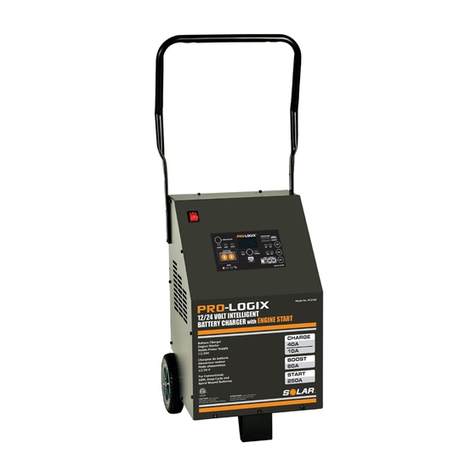
Prologix
Prologix SOLAR PL3760 User manual
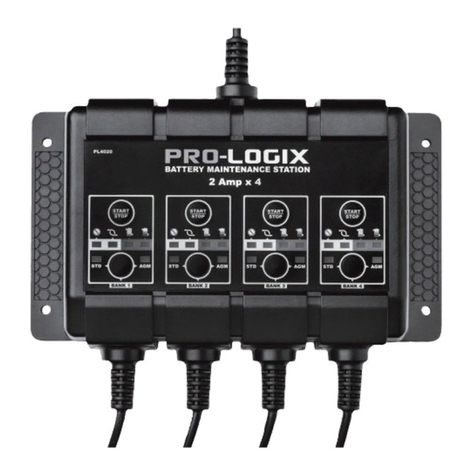
Prologix
Prologix PL4020 User manual

Prologix
Prologix Solar PL3740 User manual

Prologix
Prologix PL2110 User manual
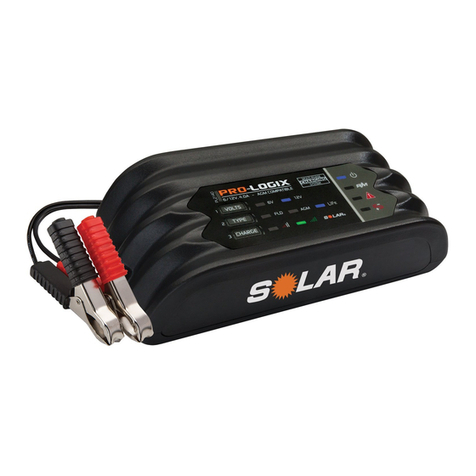
Prologix
Prologix PL2140 User manual
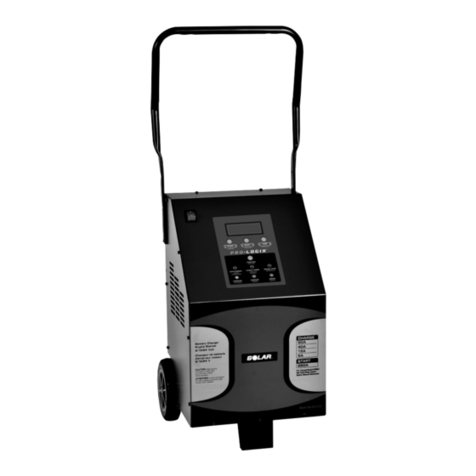
Prologix
Prologix SOLAR PL3730 User manual
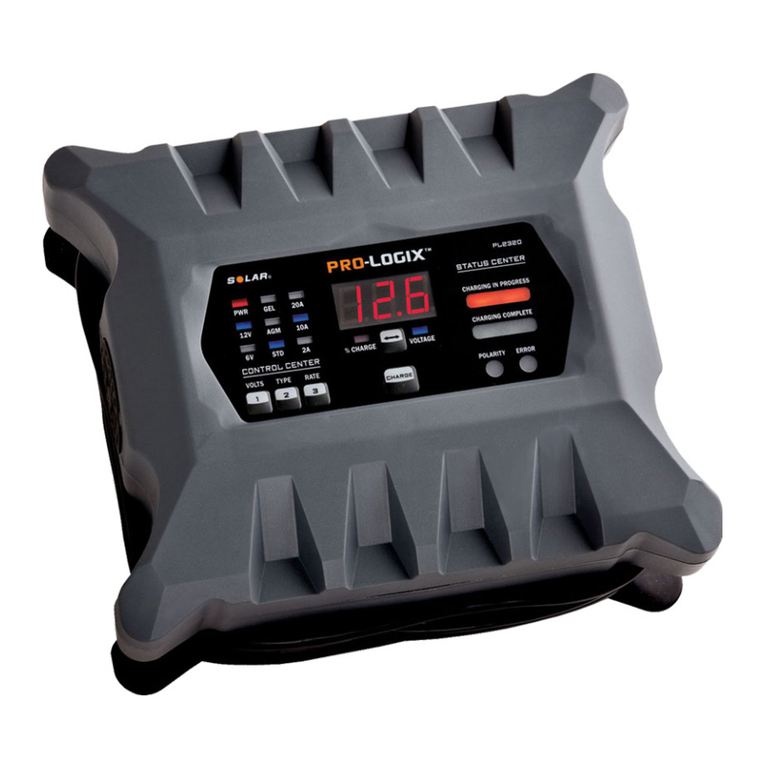
Prologix
Prologix PL2320 User manual
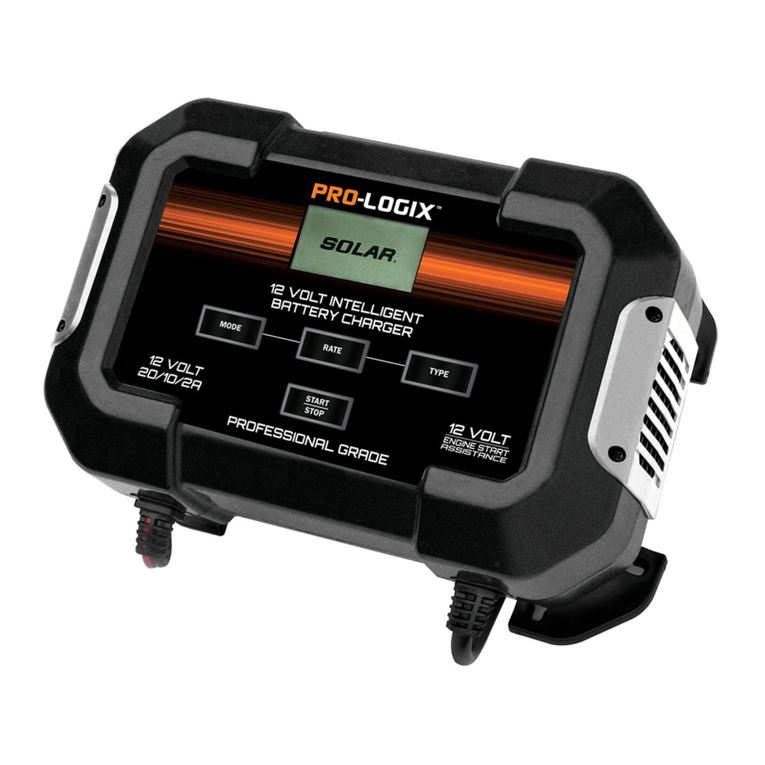
Prologix
Prologix PL2545 User manual
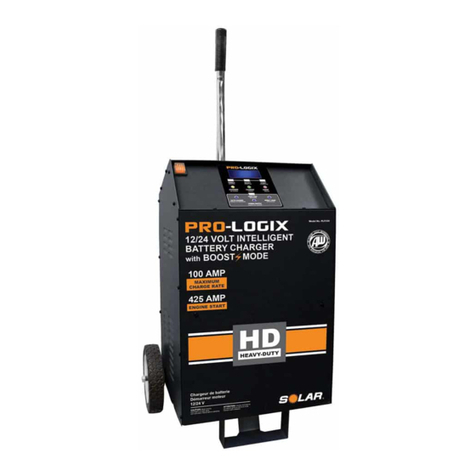
Prologix
Prologix PL5100 User manual
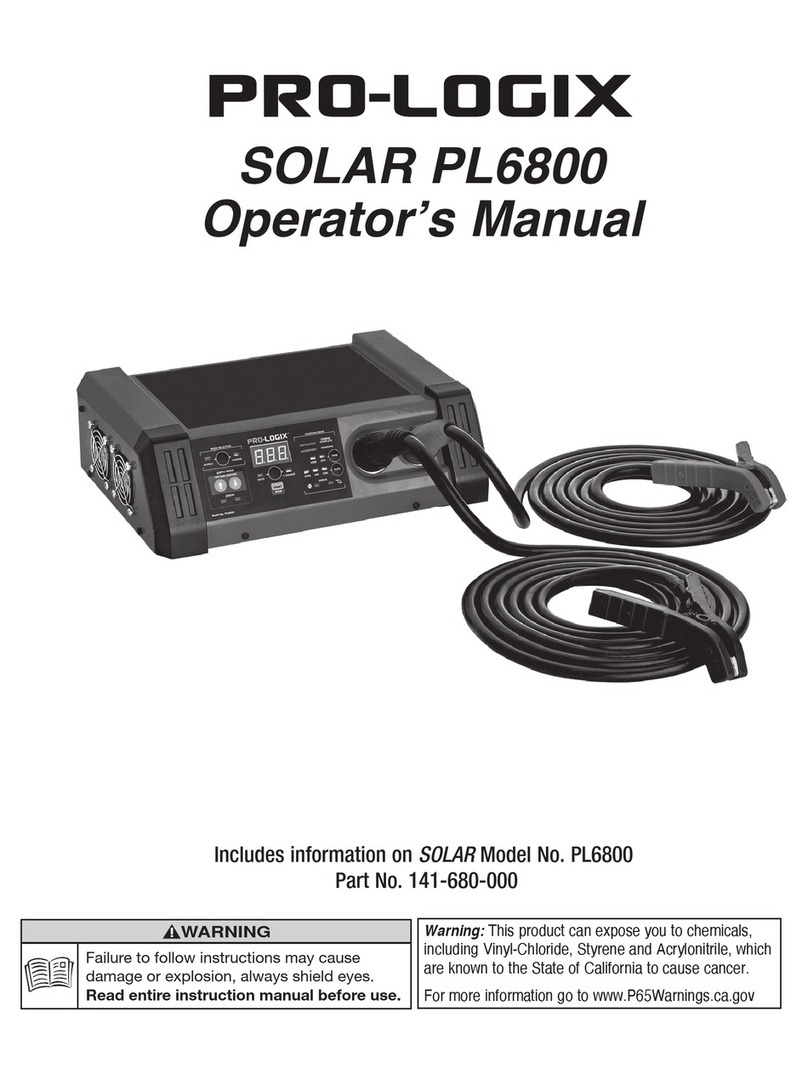
Prologix
Prologix SOLAR PL6800 User manual
